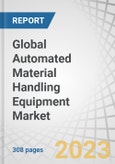Growing Number of Start-Ups Offering Robotics Solutions for Warehouse Automation
The global automated material handling equipment market is projected to reach USD 45.7 billion by 2028 from USD 30.6 billion in 2023, at a CAGR of 8.3% from 2023 to 2028. The growth of this market is attributed to the rising demand for automated material handling equipment among diverse industries and the growing number of start-ups offering robotics solutions for warehouse automation.
Unit Load segment is projected to grow at a higher CAGR during 2023-2028
Unit load material handling systems involve appropriately sized items organized into a single unit that can be moved easily. It consists in handling various items or unit formats independently, even when they are transported in large quantities or are significant in dimension. These systems are quick and economical to move several items in a single run. These systems help reduce damages and handling costs. Such systems make handling, storage, and distribution more efficient. The types of AMHE used to manage unit loads include AGVs, ASRS, and robots.
Automotive Industry to account for the largest share of market in 2023
The automotive industry players seek improvements in manufacturing through automated and efficient processes. These companies need to carry out their manufacturing and assembling operations efficiently by carefully handling various components and keeping track of it. The deployment of AMHE in this industry helps prevent damage to auto parts, reduce the cost of unproductive labor hours by handling inventory, and maximize storage capacity within the available floor space.
Asia-Pacific is anticipated to contribute the largest share of the market during the forecast period
Asia-Pacific consists of some of the fastest-growing economies - such as China, Japan, and India. Substantial domestic demand for products and significant business growth opportunities have led to the establishment of number of manufacturing and warehousing plants of various industries in the countries. These plants are of major industries such as automotive, metals & heavy machinery, and semiconductor & electronics, in the region. This in turn is offering lucrative opportunities for the automated material handling equipment market in Asia-Pacific.
The break-up of the profiles of primary participants:
- By Company Type - Tier 1 - 45%, Tier 2 - 30%, and Tier 3 - 25%
- By Designation - C-level Executives - 35%, Directors - 45%, and Others - 20%
- By Region - North America - 30%, Europe - 25%, Asia-Pacific - 35%, and Rest of the World - 10%
Major players in the automated material handling equipment market include Daifuku (Japan), KION (Germany), SSI Schaefer (Germany), Toyota Industries (Japan), and Honeywell International (US).
Research Coverage
The report segments the automated material handling equipment market into product, system type, industry, and region. The report also comprehensively reviews drivers, restraints, opportunities, and challenges influencing market growth. The report also covers qualitative aspects in addition to the quantitative aspects of the market.
Reasons to Buy the Report
The report will help the market leaders/new entrants with information on the closest approximate revenues for the overall automated material handling equipment market and related segments. This report will help stakeholders understand the competitive landscape and gain more insights to strengthen their position in the market and plan suitable go-to-market strategies. The report also helps stakeholders understand the market pulse and provides information on key market drivers, restraints, opportunities, and challenges.
The report provides insights on the following pointers:
- Analysis of key drivers (Increasing penetration of ASRS in the e-commerce industry, growing number of startups offering robotic solutions for warehouse automation, high labor costs, and safety concerns, paradigm shift from mass production to mass customization), restraints (Requirement for significant capital, high integration, and switching costs), opportunities (Substantial industrial growth in emerging economies, existence of huge intralogistics sector in Southeast Asia, growing extent of order customization and personalization), and challenges (immense technical challenges related to sensing elements, production and revenue losses due to unwanted equipment downtime) influencing the growth of the automated material handling equipment market.
- Product Development/Innovation: Detailed insights on upcoming technologies, research and development activities, and new product launches in the automated material handling equipment market.
- Market Development: Comprehensive information about lucrative markets - the report analyses the automated material handling equipment market across varied regions.
- Market Diversification: Exhaustive information about new products, untapped geographies, recent developments, and investments in the automated material handling equipment market.
- Competitive Assessment: In-depth assessment of market shares, growth strategies, and product offerings of leading players like Daifuku (Japan), KION (Germany), SSI Schaefer (Germany), Toyota Industries (Japan), and Honeywell International (US).
Table of Contents
Executive Summary
Companies Mentioned
- Addverb Technologies
- Autocrib
- Automation Logistic
- Avancon
- Beumer
- Daifuku
- Ferreto
- Grabit
- Hanwha
- Honeywell International
- Hyster-Yale Material Handling
- Invata Intralogistics
- Invia Robotics
- Jbt
- Jungheinrich
- Kion
- Knapp
- Kuka
- Locus Robotics
- Meiden America
- Mobile Industrial Robots
- Murata Machinery
- Ssi Schaefer
- Tgw Logistics
- Toyota Industries
- Viastore
- Westfalia Technologies
Methodology

LOADING...
Table Information
| Report Attribute | Details |
|---|---|
| No. of Pages | 308 |
| Published | May 2023 |
| Forecast Period | 2023 - 2028 |
| Estimated Market Value ( USD | $ 30.6 Billion |
| Forecasted Market Value ( USD | $ 45.7 Billion |
| Compound Annual Growth Rate | 8.3% |
| Regions Covered | Global |
| No. of Companies Mentioned | 27 |









